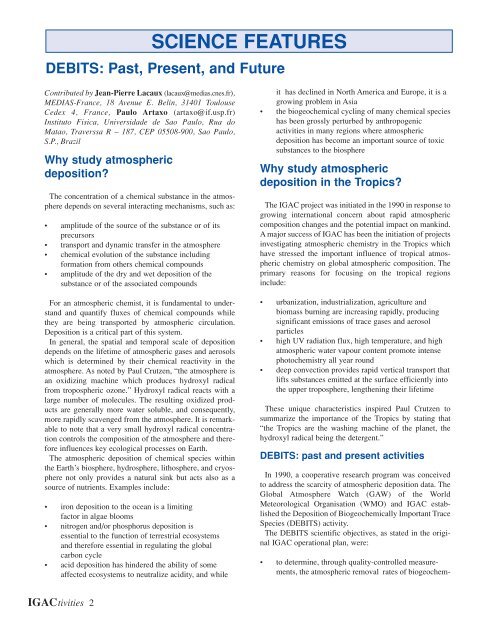Issue 27 Jan 2003 - IGAC Project
Issue 27 Jan 2003 - IGAC Project
Issue 27 Jan 2003 - IGAC Project
Create successful ePaper yourself
Turn your PDF publications into a flip-book with our unique Google optimized e-Paper software.
SCIENCE FEATURES<br />
DEBITS: Past, Present, and Future<br />
Contributed by Jean-Pierre Lacaux (lacaux@medias.cnes.fr),<br />
MEDIAS-France, 18 Avenue E. Belin, 31401 Toulouse<br />
Cedex 4, France, Paulo Artaxo (artaxo@if.usp.fr)<br />
Instituto Fisica, Universidade de Sao Paulo, Rua do<br />
Matao, Traverssa R – 187, CEP 05508-900, Sao Paulo,<br />
S.P., Brazil<br />
Why study atmospheric<br />
deposition<br />
The concentration of a chemical substance in the atmosphere<br />
depends on several interacting mechanisms, such as:<br />
• amplitude of the source of the substance or of its<br />
precursors<br />
• transport and dynamic transfer in the atmosphere<br />
• chemical evolution of the substance including<br />
formation from others chemical compounds<br />
• amplitude of the dry and wet deposition of the<br />
substance or of the associated compounds<br />
For an atmospheric chemist, it is fundamental to understand<br />
and quantify fluxes of chemical compounds while<br />
they are being transported by atmospheric circulation.<br />
Deposition is a critical part of this system.<br />
In general, the spatial and temporal scale of deposition<br />
depends on the lifetime of atmospheric gases and aerosols<br />
which is determined by their chemical reactivity in the<br />
atmosphere. As noted by Paul Crutzen, “the atmosphere is<br />
an oxidizing machine which produces hydroxyl radical<br />
from tropospheric ozone.” Hydroxyl radical reacts with a<br />
large number of molecules. The resulting oxidized products<br />
are generally more water soluble, and consequently,<br />
more rapidly scavenged from the atmosphere. It is remarkable<br />
to note that a very small hydroxyl radical concentration<br />
controls the composition of the atmosphere and therefore<br />
influences key ecological processes on Earth.<br />
The atmospheric deposition of chemical species within<br />
the Earth’s biosphere, hydrosphere, lithosphere, and cryosphere<br />
not only provides a natural sink but acts also as a<br />
source of nutrients. Examples include:<br />
• iron deposition to the ocean is a limiting<br />
factor in algae blooms<br />
• nitrogen and/or phosphorus deposition is<br />
essential to the function of terrestrial ecosystems<br />
and therefore essential in regulating the global<br />
carbon cycle<br />
• acid deposition has hindered the ability of some<br />
affected ecosystems to neutralize acidity, and while<br />
it has declined in North America and Europe, it is a<br />
growing problem in Asia<br />
• the biogeochemical cycling of many chemical species<br />
has been grossly perturbed by anthropogenic<br />
activities in many regions where atmospheric<br />
deposition has become an important source of toxic<br />
substances to the biosphere<br />
Why study atmospheric<br />
deposition in the Tropics<br />
The <strong>IGAC</strong> project was initiated in the 1990 in response to<br />
growing international concern about rapid atmospheric<br />
composition changes and the potential impact on mankind.<br />
A major success of <strong>IGAC</strong> has been the initiation of projects<br />
investigating atmospheric chemistry in the Tropics which<br />
have stressed the important influence of tropical atmospheric<br />
chemistry on global atmospheric composition. The<br />
primary reasons for focusing on the tropical regions<br />
include:<br />
• urbanization, industrialization, agriculture and<br />
biomass burning are increasing rapidly, producing<br />
significant emissions of trace gases and aerosol<br />
particles<br />
• high UV radiation flux, high temperature, and high<br />
atmospheric water vapour content promote intense<br />
photochemistry all year round<br />
• deep convection provides rapid vertical transport that<br />
lifts substances emitted at the surface efficiently into<br />
the upper troposphere, lengthening their lifetime<br />
These unique characteristics inspired Paul Crutzen to<br />
summarize the importance of the Tropics by stating that<br />
“the Tropics are the washing machine of the planet, the<br />
hydroxyl radical being the detergent.”<br />
DEBITS: past and present activities<br />
In 1990, a cooperative research program was conceived<br />
to address the scarcity of atmospheric deposition data. The<br />
Global Atmosphere Watch (GAW) of the World<br />
Meteorological Organisation (WMO) and <strong>IGAC</strong> established<br />
the Deposition of Biogeochemically Important Trace<br />
Species (DEBITS) activity.<br />
The DEBITS scientific objectives, as stated in the original<br />
<strong>IGAC</strong> operational plan, were:<br />
• to determine, through quality-controlled measurements,<br />
the atmospheric removal rates of biogeochem-<br />
<strong>IGAC</strong>tivities 2








